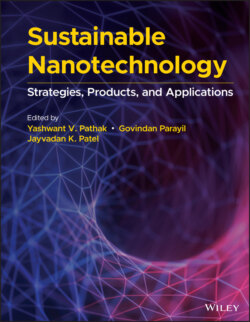Читать книгу Sustainable Nanotechnology - Группа авторов - Страница 62
2.3.2 Water Purification and Reuse
ОглавлениеNowadays, society and the global economy is facing the most critical problem, which is availability of clean water. Continuous supply of potable water for humans and in food processing, in energy generation, and in many more industries is a major challenge in many parts of the world. The combination between nanotechnology and water science technology revolutionizes the advancement in water treatment, purification, and recycling technologies [47]. Today, the available techniques for water purification are reverse osmosis or vapor compression. The available technologies for treatment of water have many limitations to provide sufficient quality to meet the requirements of humans and the environment. Hence, it is mandatory to reuse water after its exit from industry; also, we can recycle it, and it can be repurposed. Swaminathan et al. have developed nanofluidic systems that consist of membranes containing nanocapillary scale of 1 to 100 nm composed of polycarbonate sheet with measurement of 6–10 μm. The authors emphasized the effect of pore geometry, charge density, and surface charge to regulate the movement of ions or charged particles in nanopores. The authors focused on the addition of nanocapillary membrane into nanofluidic system that can manage the transport of molecules from one chemical environment to another [48]. Park et al. describe nanofibers as membrane for nanofiltration, which are made up of polyvinylidene fluoride (PVDF) and polyethyleneimine (PEI) for fabrication using electrospinning techniques with improved performance of nanofiltration for purification of water [49]. Usually, nanoadsorbents are very effective in eliminating pollutants from wastewater. Ali studied the benefit of using nanoadsorbents for treatment of wastewater due to its special properties such as very small size with larger surface area having lots of active sites for binding, which gives ease of separation [50]. Today, polymeric nanoadsorbents are more promising due to their excellent adsorption capacity and thermal stability in all pH range [51].
